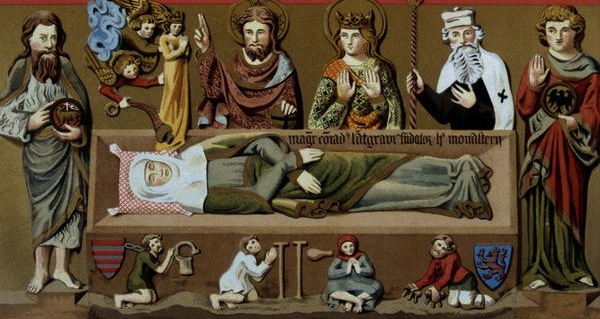What you need, as a Christian, is Jesus in your heart and the Trinity in your guts. At least that’s what Clare of Montefalco had.
Today (August 18) was the day that Clare of Montefalco (1268-1308) died. Clare entered the Augustinian convent at age nine. By the end of her life she was abbess of the monastery in Montefalco, Umbria, and was famous for her piety. She had a number of visions and several experiences of prolonged spiritual ecstasy. In one vision she saw herself standing before the judgement seat of God. In another, Mary and the Christ-child approached, and the Christ child gave her an embrace. She felt an overpowering sense of joy, but a lingering conviction of unworthiness. Her spiritual disciplines were very ascetic, and one scholar says that “the major emphasis in all the documents and biographies is Clare’s desire to share the physical suffering of Christ.”
Clare’s most famous vision involved seeing Jesus as a wanderer, carrying his cross through the world with nowhere to plant it. Clare offered to take it, and Christ spoke to her: “I have sought a place in the world where I might plant my cross, and have found no better site than your heart.” In paintings, Clare is usually shown standing over against this vision of Christ, who is planting the foot of his cross in her chest. Clare testified that the implanting of the cross caused her great excruciating pain, a pain which did not go away.
Here’s where the story gets strange. When she died, the sisters of her order performed an autopsy. They examined her heart and found the proofs they were sure would be there: inside her heart was a cross. It was a little, white, two-inch-tall crucifix with a figure of Christ on it, complete enough that the wound in his side could be seen. They kept searching in the heart, and found more: the lance that pierced his side was also there, and the long reed with a sponge on the end. And the crown of thorns, and three nails. Plus the whipping post where he had been beaten, and the flagellum. All the major implements of the passion were there as tiny physical objects in the heart of Clare of Montefalco.
As the autopsy continued, the sisters found something else: In her gall bladder, they discovered three pellets arranged triangularly. They were joined together, and each the size of a small hazelnut. They were declared to be a symbol of the Trinity. Literature available at the shrine in Montefalco (Sanctuario S. Chiara da Montefalco) says that the stones had amazing physical properties: “any one of them was as heavy as the other two, and at times any one of them equalled the weight of all three together.” I doubt you are allowed to weigh them, but these three stones are still on display in Montefalco under a circular crystal.
The results of the autopsy were reported, and Clare’s posthumous fame soared. Her disembodied heart worked miracles wherever it was taken. Her body did not decay, and reportedly remains incorrupt to this day. She seemed to be on the fast track to sainthood. Her case was officially documented by 1313, and by 1318 Pope John XXII had sent cardinals to make an official report. For some reason the canonization process was halted, and was not concluded until 1881 when Clare was declared a saint.
I’ve never been, but apparently in Montefalco you can see all of this: The undecayed body of Clare of the Cross, as she is also known; along with the tiny white crucifix from her heart, and all the accompanying implements of the passion of Christ. And those three little stones symbolizing the Trinity.
I don’t believe a bit of it. The stones in particular remind me a bit too much of the church that had the head of John the Baptist at one end, and the head of John the Baptist as a child at the other end. I also can’t get over the autopsy element of the story, the very thing that attracted the attention of the original Goth, Montague Summers, to the story of Clare.
But call me a completist in my obsession with the Trinity: If I’m ever near Montefalco, Italy, I fear I must see the trinitarian stones extracted from the gall bladder of Clare of Montefalco.
